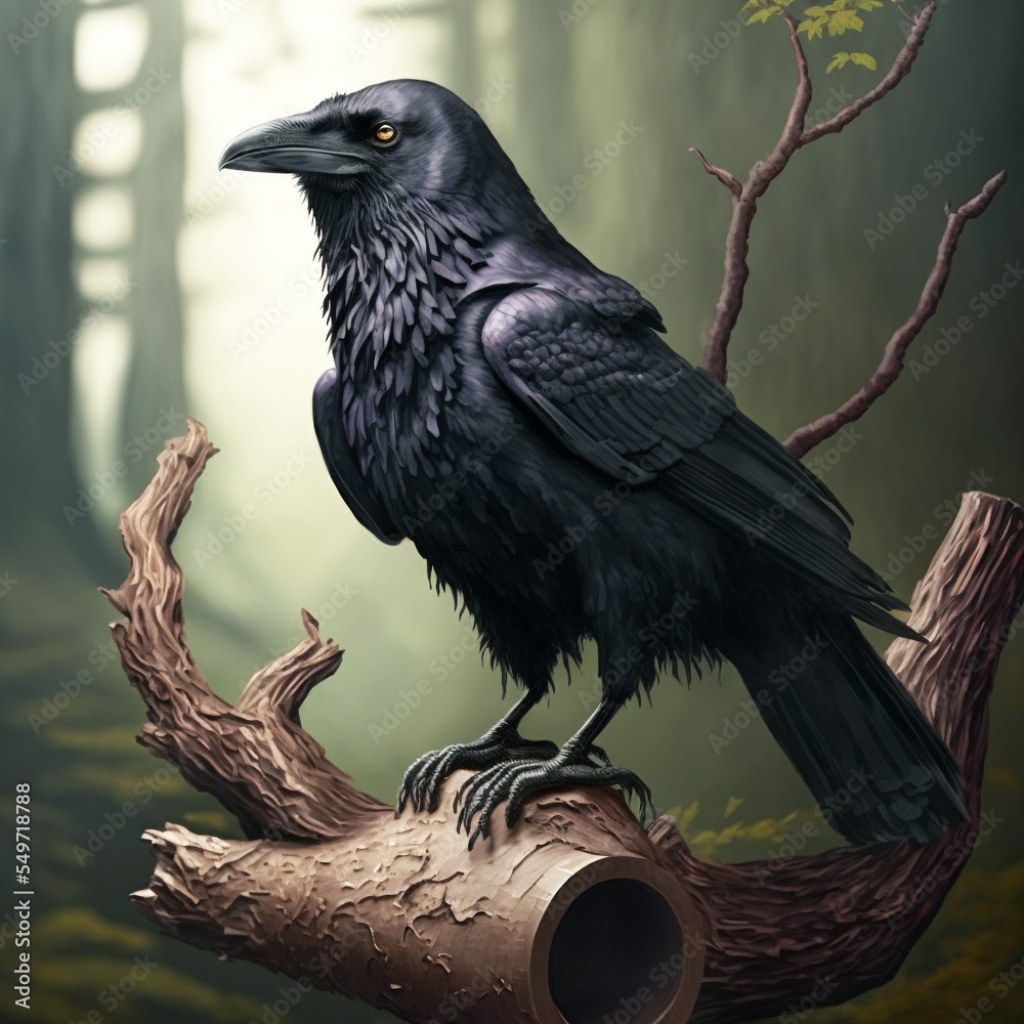Captivating Click: Enchanting Raven On Branch Spotlight
Raven on Branch: A Majestic and Mysterious Sight
Introduction
Greetings, Raven Enthusiast!
1 Picture Gallery: Captivating Click: Enchanting Raven On Branch Spotlight

Welcome to the captivating world of ravens perched on branches. In this article, we will explore the fascinating characteristics and behavior of these majestic birds. Prepare to delve into the realm of these enigmatic creatures and discover the allure they hold for both nature enthusiasts and curious minds.

Image Source: ftcdn.net
Let us embark on an enlightening journey into the realm of ravens on branches, unravelling their significance and shedding light on their mysterious presence.
So, without further ado, let us dive into the world of the raven on branch and unravel its secrets!
What is a Raven on Branch?
🌟 The Elegance of a Raven on Branch 🌟
A raven on branch is a captivating sight that has captivated individuals throughout history. These intelligent birds, known for their striking black feathers and haunting calls, are often spotted perched on branches. Their presence exudes an air of mystery and fascination among both casual observers and avid birdwatchers.
🏞️ The Natural Habitat of Ravens 🏞️
Ravens primarily inhabit forested areas, where they establish their territories and build their nests. Their favored perching spots are often high branches, granting them a vantage point to monitor their surroundings and spot potential prey or threats.
🐦 The Raven’s Role in Ecosystems 🐦
Ravens play an essential role in maintaining ecosystem balance. They are scavengers, feeding on carrion and acting as nature’s clean-up crew. By consuming decaying organic matter, ravens prevent the spread of diseases and contribute to the overall health of their habitats.
🌳 The Symbolic Significance of Ravens 🌳
Ravens have held symbolic significance in various cultures and mythologies throughout time. Often associated with wisdom and foreboding, ravens have been depicted as messengers or companions of deities in folklore and literature. Their presence evokes a sense of intrigue and the supernatural.
🔎 Understanding Raven Behavior 🔎
Studying raven behavior can provide valuable insights into their habits and social structure. Ravens are highly intelligent and form complex social hierarchies. They communicate through a variety of vocalizations and gestures, enabling them to coordinate group activities and protect their territories.
🗺️ Distribution of Ravens 🗺️
Ravens can be found in various regions around the world, including North America, Europe, Asia, and North Africa. Their adaptability allows them to thrive in diverse environments, ranging from snowy mountain peaks to coastal regions.
🌠 The Mystique of the Raven on Branch 🌠
The combination of the raven’s striking appearance, intriguing behavior, and rich symbolism makes the sight of a raven on a branch an awe-inspiring experience. Gazing upon this enigmatic creature, one cannot help but be drawn into its mysterious world.
Who Loves Ravens on Branches?
🌟 Nature Enthusiasts and Birdwatchers 🌟
Nature enthusiasts and birdwatchers are particularly enchanted by the sight of a raven on a branch. Their profound appreciation for the beauty and intricacies of the natural world fuels their fascination with these elegant birds.
🖋️ Artists and Writers 🖋️
The artistic community draws inspiration from the raven’s allure. Artists depict ravens on branches in paintings, sculptures, and other forms of creative expression. Writers incorporate the symbolism and mystique of ravens into their works, evoking a sense of intrigue and enchantment.
👨🏫 Researchers and Scientists 👩🎓
Ravens on branches have also captured the attention of researchers and scientists. Their intelligence and unique behaviors have made them subjects of study in fields such as animal behavior, ecology, and cognitive science. By observing ravens in their natural habitat, scientists gain valuable insights into the complexities of avian cognition and social dynamics.
🌍 Environmentalists and Conservationists 🌍
For environmentalists and conservationists, the presence of ravens on branches signifies a healthy and thriving ecosystem. These individuals strive to protect the habitats of ravens and other wildlife, recognizing their crucial role in maintaining biodiversity and ecological balance.
🌟 Cool Peoples 👍
Last but not least, the allure of the raven on branch extends to anyone with an appreciation for nature’s wonders. Cool Peoples from all walks of life can find joy and inspiration in witnessing the majesty of these birds perched on branches.
When and Where to Spot Ravens on Branches?
📅 Time of Year 📅
Ravens can be spotted on branches throughout the year. However, their activity may vary depending on the season. During breeding season, which typically occurs in the spring, ravens are more likely to be seen engaging in courtship displays or tending to their young. In colder months, they may gather in larger groups, seeking warmth and food sources.
📍 Ideal Habitats 📍
Ravens favor habitats with an abundant supply of food and suitable nesting sites. Forested areas, including both coniferous and deciduous forests, provide them with the necessary resources for survival. Additionally, coastal regions, mountainous terrain, and even urban environments can serve as habitats for these adaptable birds.
🕒 Best Times of Day 🕒
Ravens are diurnal creatures, meaning they are most active during daylight hours. Early morning and late afternoon are opportune times to spot ravens on branches as they prepare for the day ahead or wind down after a day of foraging and socializing.
🗺️ Global Distribution 🗺️
Ravens are found across various regions worldwide, occupying both Northern and Southern Hemispheres. In North America, common raven populations span from Canada to Mexico. In Europe, they can be seen in countries such as the United Kingdom, Germany, and Spain. Asian countries, including China and Japan, also boast thriving raven populations.
🌍 Local Hotspots 🌍
While ravens can be encountered in numerous locations, some areas are renowned for their high raven populations. National parks, nature reserves, and wildlife sanctuaries often provide prime opportunities for observing ravens on branches. Examples include Yellowstone National Park in the United States, Snowdonia National Park in Wales, and Hokkaido in Japan.
Why are Ravens on Branches Fascinating?
🌟 Intelligent Creatures 🌟
Ravens are known for their exceptional intelligence. Their problem-solving abilities and capacity for complex social interactions have astounded researchers. Ravens can use tools, imitate sounds, and even recognize themselves in mirrors – a trait shared by only a few select species.
⚡ Cultural and Mythological Significance ⚡
The cultural and mythological significance of ravens spans across centuries and civilizations. From Native American folklore to Norse mythology, ravens have been revered as symbols of wisdom, magic, and prophecy. This rich tapestry of cultural references adds to the allure of ravens on branches.
🎵 Haunting Calls and Vocalizations 🎵
Noise pollution is not an issue when it comes to ravens. Their deep, resonant croaks and a wide range of other vocalizations echo through forests and open spaces. These calls serve various purposes, from establishing territory boundaries to communication within social groups.
🌳 Nature’s Clean-up Crew 🌳
As opportunistic scavengers, ravens play a crucial role in ecosystems. Their diet includes carrion and decaying organic matter, which they consume on the ground or in trees. By disposing of carcasses, ravens help prevent the spread of diseases and maintain the overall health of the environment.
✨ Beautiful and Intimidating Presence ✨
The raven’s glossy black plumage and piercing eyes give it an air of mystery and elegance. Its large size and commanding presence evoke both admiration and a touch of fear. Observing a raven perched on a branch, silhouetted against the sky, is a sight that ignites the imagination.
How Do Ravens End Up on Branches?
🌟 Flight Patterns of Ravens 🌟
Ravens are agile flyers, capable of soaring through the air with grace and precision. They utilize thermals and updrafts to conserve energy during flight, often taking advantage of these natural phenomena when moving between perching spots or foraging areas.
🌲 Choosing the Perfect Perching Spot 🌲
When selecting a branch to perch on, ravens consider factors such as visibility, safety, and proximity to food sources. They prefer sturdy branches that can support their weight, providing them with a secure vantage point to observe their surroundings and potential prey.
🌳 The Art of Landing 🌳
Landing gracefully on a branch requires skill and precision. Ravens approach their desired perching spot with their wings spread and their feet extended, ready to grasp the branch upon contact. With a slight adjustment of their body position, they perch confidently on their chosen branch.
🚀 Taking Off into Flight 🚀
To take flight from a branch, ravens push off with their powerful legs, propelling themselves into the air. They then use their wings to generate lift and maneuver through the sky. Once airborne, they can soar for extended periods, using thermals and air currents to optimize their flight efficiency.
🗺️ Navigating Vast Territories 🗺️
Ravens are known for their wide-ranging territories, which they diligently defend against intruders. Their ability to navigate within these expansive areas showcases their exceptional spatial awareness and orientation skills. Ravens often use prominent landmarks and geographic features to orient themselves during flight.
🌠 Perching Etiquette 🌠
When multiple ravens are perched on the same branch or in close proximity, a hierarchy often emerges. Dominant individuals typically occupy higher perches, while subordinates position themselves lower down. This social structure helps maintain order and reduces conflict among group members.
🌲 Building Nests in Treetops 🌲
Ravens construct their nests in the upper branches of trees, often using twigs, moss, and other natural materials. These nests provide a safe haven for raising their young and offer an elevated perch for adult ravens to survey their surroundings.
Advantages and Disadvantages of Ravens on Branches
Advantages:
1. Ecosystem Services: Ravens play a crucial role in maintaining the balance of ecosystems by scavenging and disposing of carcasses, reducing disease transmission and maintaining environmental hygiene.
2. Intelligence and Adaptability: The intelligence and adaptability of ravens enable them to thrive in various habitats and adjust their behavior to changing circumstances, ensuring their survival.
3. Cultural Significance: Ravens have enriched human culture through their symbolism and appearances in myths, legends, and literature, inspiring artists and intriguing individuals with their deep-rooted significance.
4. Fascination and Awe: The sight of ravens on branches evokes a sense of fascination and awe, offering a connection to the natural world and reminding us of the wonders that exist beyond our daily lives.
5. Research Opportunities: The intelligence and complexity of raven behavior provide abundant research opportunities in fields such as animal cognition, social dynamics, and ecology, contributing to our understanding of the natural world.
Disadvantages:
1. Crop and Livestock Predation: In certain situations, ravens may pose a threat to agricultural interests by preying on crops or young livestock. However, such occurrences are relatively rare and localized.
2. Nesting Site Competition: The search for suitable nesting sites can lead to competition among ravens and other bird species, potentially impacting local populations and biodiversity in certain areas.
3. Noise Disturbances: The vocal nature of ravens can occasionally result in noise disturbances, especially in urban environments where their calls may echo and be perceived as a nuisance.
4. Misconceptions and Folklore: Misconceptions and stereotypes surrounding ravens may perpetuate negative beliefs or superstitions about these birds, leading to undeserved persecution or fear.
5. Habitat Loss and Fragmentation: Human activities such as deforestation and urbanization can lead to habitat loss and fragmentation, posing challenges to raven populations and their ability to find suitable perching spots.
Frequently Asked Questions (FAQ)
This post topic: Raven


